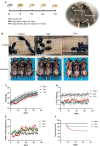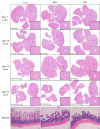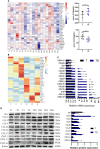A Mouse Model of Damp-Heat Syndrome in Traditional Chinese Medicine and Its Impact on Pancreatic Tumor Growth
- PMID: 35957897
- PMCID: PMC9357947
- DOI: 10.3389/fonc.2022.947238
A Mouse Model of Damp-Heat Syndrome in Traditional Chinese Medicine and Its Impact on Pancreatic Tumor Growth
Abstract
Background: Damp-heat syndrome is one of the most important syndrome types in the traditional Chinese medicine (TCM) syndrome differentiation and treatment system, as well as the core pathogenesis of pancreatic cancer (PC) which remains a challenge to medical researchers due to its insidious onset and poor prognosis. Great attention has been given to the impact of damp-heat syndrome on tumorigenesis and progression, but less attention has been given to damp-heat modeling per se. Studying PC in a proper damp-heat syndrome animal model can recapitulate the actual pathological process and contribute to treatment strategy improvement.
Methods: Here, an optimized damp-heat syndrome mouse model was established based on our prior experience. The Fibonacci method was applied to determine the maximum tolerated dosage of alcohol for mice. Damp-heat syndrome modeling with the old and new methods was performed in parallel of comparative study about general appearance, food intake, water consumption and survival. Major organs, including the liver, kidneys, lungs, pancreas, spleen, intestines and testes, were collected for histological evaluation. Complete blood counts and biochemical tests were conducted to characterize changes in blood circulation. PC cells were subcutaneously inoculated into mice with damp-heat syndrome to explore the impact of damp-heat syndrome on PC growth. Hematoxylin-eosin staining, Masson staining and immunohistochemistry were performed for pathological evaluation. A chemokine microarray was applied to screen the cytokines mediating the proliferation-promoting effects of damp-heat syndrome, and quantitative polymerase chain reaction and Western blotting were conducted for results validation.
Results: The new modeling method has the advantages of mouse-friendly features, easily accessible materials, simple operation, and good stability. More importantly, a set of systematic indicators was proposed for model evaluation. The new modeling method verified the pancreatic tumor-promoting role of damp-heat syndrome. Damp-heat syndrome induced the proliferation of cancer-associated fibroblasts and promoted desmoplasia. In addition, circulating and tumor-located chemokine levels were altered by damp-heat syndrome, characterized by tumor promotion and immune suppression.
Conclusions: This study established a stable and reproducible murine model of damp-heat syndrome in TCM with systematic evaluation methods. Cancer associated fibroblast-mediated desmoplasia and chemokine production contribute to the tumor-promoting effect of damp-heat syndrome on PC.
Keywords: cancer-associated fibroblasts; chemokines; damp-heat syndrome; evaluation indicators; mouse model; pancreatic tumor.
Copyright © 2022 Jiao, Cheng, Xu, Yang, Ruan and Chen.
Conflict of interest statement
The authors declare that the research was conducted in the absence of any commercial or financial relationships that could be construed as a potential conflict of interest.
Figures







Similar articles
-
Characteristics of Gut Microbiome in the Murine Model of Pancreatic Cancer with Damp-Heat Syndrome.Biomedicines. 2024 Oct 16;12(10):2360. doi: 10.3390/biomedicines12102360. Biomedicines. 2024. PMID: 39457673 Free PMC article.
-
[Construction of MHV-A59 damp-heat mouse model and analysis of the relevant indices].Nan Fang Yi Ke Da Xue Xue Bao. 2010 Nov;30(11):2452-4. Nan Fang Yi Ke Da Xue Xue Bao. 2010. PMID: 21097403 Chinese.
-
[Meta-analysis of single-group rate of the distribution of traditional Chinese medicine syndromes in 2 139 patients with coronavirus disease 2019].Zhonghua Wei Zhong Bing Ji Jiu Yi Xue. 2020 Jun;32(6):664-670. doi: 10.3760/cma.j.cn121430-202000509-00372. Zhonghua Wei Zhong Bing Ji Jiu Yi Xue. 2020. PMID: 32684209 Chinese.
-
Gender differences in Damp-Heat Syndrome: A review.Biomed Pharmacother. 2021 Nov;143:112128. doi: 10.1016/j.biopha.2021.112128. Epub 2021 Sep 4. Biomed Pharmacother. 2021. PMID: 34492424 Review.
-
Traditional Chinese medicine for prevention and treatment of hepatocarcinoma: From bench to bedside.World J Hepatol. 2015 May 28;7(9):1209-32. doi: 10.4254/wjh.v7.i9.1209. World J Hepatol. 2015. PMID: 26019736 Free PMC article. Review.
Cited by
-
Characteristics of Gut Microbiome in the Murine Model of Pancreatic Cancer with Damp-Heat Syndrome.Biomedicines. 2024 Oct 16;12(10):2360. doi: 10.3390/biomedicines12102360. Biomedicines. 2024. PMID: 39457673 Free PMC article.
References
-
- He L, Bao T, Yang Y, Wang H, Gu C, Chen J, et al. . Exploring the Pathogenesis of Type 2 Diabetes Mellitus Intestinal Damp-Heat Syndrome and the Therapeutic Effect of Gegen Qinlian Decoction From the Perspective of Exosomal Mirna. J Ethnopharmacol (2021), 285:114786. doi: 10.1016/j.jep.2021.114786 - DOI - PubMed
-
- You L, Zhang S, Li T, Sang X, Li K, Wang W, et al. . Integrated Analyses of Mirna and Mrna Profiles in Leukocytes and Serums in Traditional Chinese Medicine (Tcm)-Defined Pi-Qi-Deficiency Syndrome and Pi-Wei Damp-Heat Syndrome Resulting From Chronic Atrophic Gastritis. Chin Med (2021) 16(1):4. doi: 10.1186/s13020-020-00416-9 - DOI - PMC - PubMed
LinkOut - more resources
Full Text Sources

